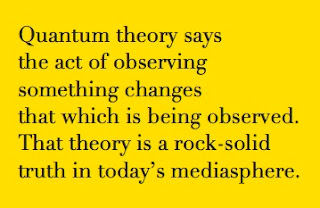Persons of interest: Charles Ramsey
and the meme parade
KNICKERS ARE in a serious twist over Charles Ramsey’s ascension to the top of the meme-of-the-moment pyramid, for his role early this week in the rescue of three women held captive for 10 years or longer in a row house in Cleveland, Ohio. Ramsey’s plain-spoken recounting of the experience has aroused volatile passions as to whether he’s being used, or whether he reflects nothing more than a mainstream media fascination with blacks as curiosities.
Much of the hue and cry overlooks the ways our society as a whole plays a role in such 60-second canonizations, and, following on that, the way all members of our contemporary, visually-driven American society are subject to the same experience.
Andy Warhol’s celebrated prediction on pop culture’s persistence has been invoked time and time again: “Every
◊ ◊ ◊
Helene Andrews, a Root contributing editor, wrote Tuesday in The Root about Ramsey, and two other meme-comets, Sweet Brown (famed for saving her own life in an apartment fire) and Antoine Dodson (whose rescue of his sister from an attacker led to comments that became a YouTube sensation). Andrews said that: “What's happening now, with the seemingly prolific oversharing of problematic depictions of poor black folk, is less an issue with the images themselves than our own voracious consumption of them.”
Aisha Harris, in a Tuesday essay at Slate, seemed to agree. “It’s difficult to watch these videos and not sense that their popularity has something to do with a persistent, if unconscious, desire to see black people perform. Even before the genuinely heroic Ramsey came along, some viewers had expressed concern that the laughter directed at people like Sweet Brown plays into the most basic stereotyping of blacks as simple-minded ramblers living in the 'ghetto,’ socially out of step with the rest of educated America.”
Andrews again: “But is the issue with the factory? The anonymous Internet machine churning out one screwed and chopped video after another? Or does the product itself have any liability here? The flash impulse to perform, as opposed to the exploitation of the performer, seems like the most interesting issue.”
◊ ◊ ◊
BUT ANDREWS leaves out the indispensable third leg of the three-legged stool of the meme industry: The consumer. Neither the factory nor the product can function, or last very long, without the consumer. The Internet shows us every day how the consumer creates more and more of the product in this relationship, how the consumer makes the factory what it is today.
 That’s the most interesting issue here: It’s the fact that the “flash impulse to perform” isn’t a respecter of race, religion, gender or anything else. These videos that focus on exponents of the foibles of the African American underclass aren’t necessarily there to perpetuate a malign, insensitive world view of black Americans. Those videos are out there, they’ve attracted the popular attention, because they reveal the fundamental aspect of performance that’s built into the culture we live in. All of us. Regardless of race.
That’s the most interesting issue here: It’s the fact that the “flash impulse to perform” isn’t a respecter of race, religion, gender or anything else. These videos that focus on exponents of the foibles of the African American underclass aren’t necessarily there to perpetuate a malign, insensitive world view of black Americans. Those videos are out there, they’ve attracted the popular attention, because they reveal the fundamental aspect of performance that’s built into the culture we live in. All of us. Regardless of race. It’s a premise basic to Erwin Schrodinger’s Cat, some of Werner Heisenberg’s uncertainty principle, and the study of quantum theory: The act of observing something changes that which is being observed. While that may still be theory in the scientific world, it’s never been more of a rock-solid truth than it is in the mediasphere of today, the era of 24-hour cable news, YouTube, Facebook and the Twitterverse. And cat videos forever.
Society at large is the main source of today’s viral performance art. In a culture shot through with cameras on lightpoles, in places of business, in smartphones and on public conveyances, the act of being observed, recorded and ridiculed is an ecumenical experience, one that pulls everything and everyone into the Great Lens. We’re all persons of interest. All of us. Regardless of race.
◊ ◊ ◊
It can’t have escaped the attention of the serious student of pop culture that, before the Charles Ramsey rescue, people were abuzz about the Sunday marriage of “Here Comes Honey Boo Boo” redneck reality-TV star June “Mama June” Shannon and her longtime paramour, Mike “Sugar Bear” Thompson. The bride wore camouflage and orange.
For more than four years, Jodi Arias, who is Hispanic, was the meme poster child for outlandish behavior — until her conviction in Arizona on
You’re hard-pressed to prove how the act of their being observed didn’t change whatever they were doing.
◊ ◊ ◊
BLACK FOLKS as gifted oddballs is nothing new, of course. Remember Nathaniel Ayers, the troubled black Juilliard-educated cellist whose story Los Angeles Times reporter Steve Lopez transformed into attention that led to a Major Motion Picture?
Or how about Ted Williams, the black homeless man with a “God-given gift of voice” discovered by a videographer at The Columbus News-Dispatch? It’s true that their discoveries changed the basic way they did what they did and how, and how well, they moved through the world from then on.
But there’s nothing that happened to them in the teleculture that didn’t happen to Joe the Plumber, the white guy who tried to be Barack Obama’s bête noire in the 2008 campaign, only to achieve a certain reflexive comic notoriety within the conservative movement, and the political culture in general. And don’t forget Orly Taitz, the Moldavian-born lawyer, dentist and darling of the birther movement whose antic attempts at disproving the citizenship of President Obama got more ridiculous and insistent the more she knew she was the subject of media attention.
The meme parade has now begun. Again. As usual, it pulls no punches; it plays no favorites that society doesn’t have already. At the end of the day, it plays no favorites at all. The appetite for information, for content 24/7, knows no letup, even if it’s content without context. Especially if it’s content without context.
The video identities of Ramsey, Williams, Taitz and all the rest are thoroughly connected to our “voracious consumption” of those identities; one is utterly dependent on the other. And in an omnivorous media culture like the one we live in, there’s really little distinction between one in flagrante delicto moment, one embarrassment, and the next. Outrageousness is an equal opportunity employer.
Image credits: Charles Ramsey: Public domain. Antoine Dodson: via YouTube. Mama June and Sugar Bear: Jason Winslow/Splash News. Ted Williams: Columbus News-Dispatch. Orly Taitz: FiredUpMissouri, via Wikipedia.

.jpg)
.jpg)

.jpg)

.jpg)
Comments
Post a Comment